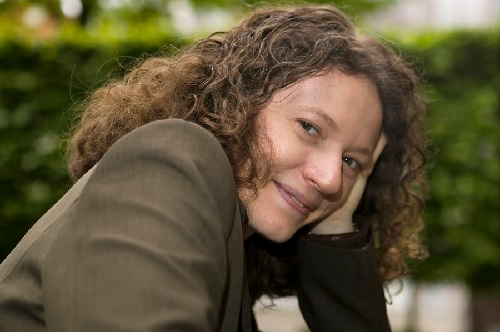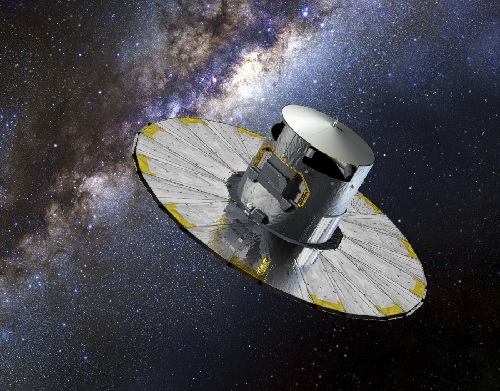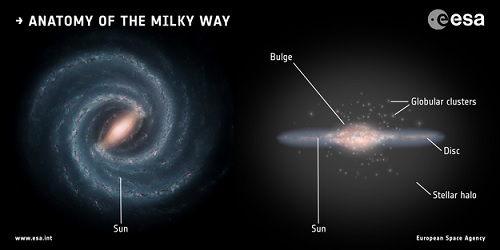Trolley dash through the galaxy
It is going to be like Harrod's Christmas sale. Astronomers are about to embark on a mad trolley dash through the galaxy. It’s not t-shirts or the latest gadgets that they’re after, but the brightness and position of a billion stars, as recorded by the Gaia satellite. The data will be made publicly available on Wednesday 14 September.

Astronomical data is usually only gradually made public. Those who have paid for the satellite or telescope are allowed to browse through it before the rest of the astronomy world can. ‘But Gaia was funded by the European Space Agency ESA,’ explains University of Groningen astronomer Amina Helmi . As ESA also works with non-European partners, it decided to make the data publicly available in one fell swoop.
So at half past twelve on Wednesday afternoon (Dutch time) the data archive and a number of copies will go online. From that moment, any astronomer will be able to browse through a terabyte of data. ‘It’s some of the data from the first one-and-a-half years of the Gaia mission,’ says Helmi. She and two of her colleagues from the Kapteyn Astronomical Institute are in the group of scientists who validated the Gaia data: ‘We looked at whether the measurements were of a high enough quality.’
Interactive
If that were not enough, Maarten Breddels, a postdoc from Helmi’s group, has developed Vaex, a software package that converts the data into a star chart including a billion stars. ‘This makes it possible to analyse Big Data. Within a second you can convert a billion details into an interactive graph that you can set to work on straight away,’ explains Helmi. ‘It’s an exceptional and innovative piece of software, and could also be of use to other disciplines.’ The software package is open source too, so anyone can download it.

Won’t it be a bloodbath on Wednesday then, with everyone wanting to be the first to study the data? Helmi laughs. ‘Perhaps, but I think it’ll be alright. There are so many things that you can study with the data that I think there’s enough for everyone.’
Gaia measures the brightness, position and movement of a billion stars and does this with great precision. The information could be used to find out how our Milky Way evolved, Helmi’s research theme. ‘I’ve currently got this kind of data for a much smaller number of stars, and these are close to the sun. It’s as if I now know a lot about a small village, but will soon gain information about the whole world.’ And the Gaia data is about a hundred times more precise than what is currently available.
Long wait
Helmi has been working on Gaia for about 20 years. ‘I helped define the mission that ESA approved in 2000.’ Her involvement continued, this time in the construction of the satellite, which eventually launched in 2013. And she has now verified the quality of the data. ‘We were under strict orders not to use it for our scientific research. For that we too have to wait until Wednesday.’

What does she plan to do? Her group of eight has been preparing for some time already. ‘What do you want to know? How will you measure that in the Gaia data? Which other data do you need for this? Which software?’ They are set to get cracking at 12.30 on the dot on Wednesday. ‘I hope to be able to answer a few questions by Thursday already, but the first publications will take some months.’
Before she can do anything on Wednesday, she will first be giving a short speech. ‘We’re broadcasting a livestream from ESA to mark the publication of the data. When the time comes, I’ll say a few words.’ And then time to log in and set to work? ‘Our group usually meets to discuss our work on a Thursday. Next Thursday we’ll be bringing our laptops.’
Read more about the Gaia mission on the ESA website
| Last modified: | 20 February 2025 11.46 a.m. |
More news
-
24 March 2025
UG 28th in World's Most International Universities 2025 rankings
The University of Groningen has been ranked 28th in the World's Most International Universities 2025 by Times Higher Education. With this, the UG leaves behind institutions such as MIT and Harvard. The 28th place marks an increase of five places: in...
-
05 March 2025
Women in Science
The UG celebrates International Women’s Day with a special photo series: Women in Science.
-
16 December 2024
Jouke de Vries: ‘The University will have to be flexible’
2024 was a festive year for the University of Groningen. In this podcast, Jouke de Vries, the chair of the Executive Board, looks back.

